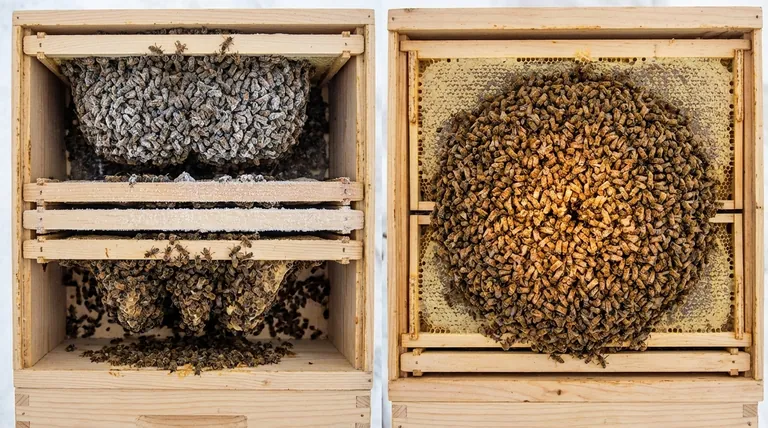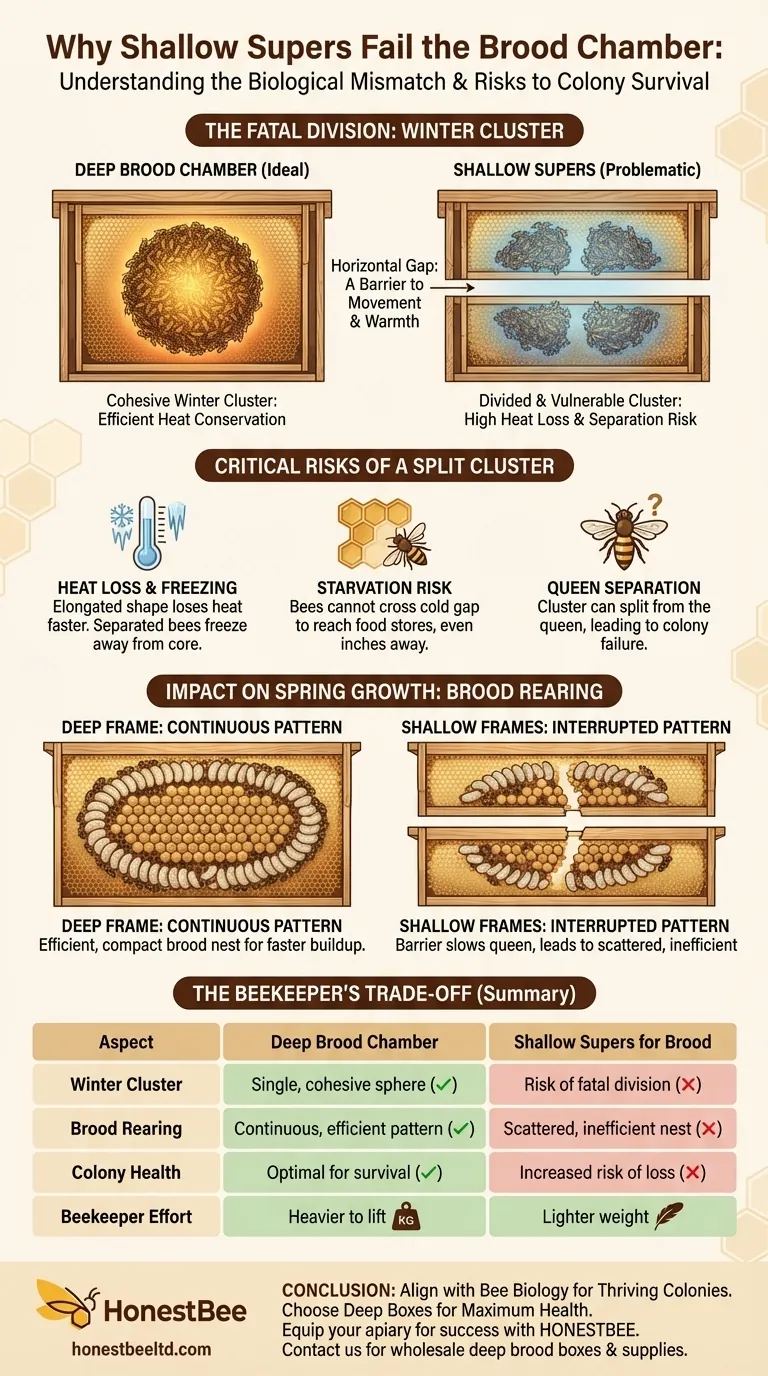Using shallow supers for the brood chamber is generally not recommended, as it directly conflicts with the honeybee's essential survival strategy for winter. The horizontal gap created between two shallow boxes can fatally divide the bees' winter cluster, preventing them from maintaining warmth and accessing their honey stores.
The core issue is biological mismatch. A deep, uninterrupted brood chamber aligns with the bees' natural need to form a single, mobile cluster for warmth and to raise young in a continuous pattern, while stacked shallow boxes create an artificial barrier that undermines these instincts.

The Critical Role of the Winter Cluster
To understand the problem, we must first understand how a honeybee colony survives the cold. They don't heat the hive; they heat themselves.
A Single, Cohesive Sphere
During cold months, bees form a tight, spherical cluster. The bees on the inside generate heat by vibrating their wing muscles, while the bees on the outside form a dense, insulating mantle.
This entire cluster functions as a single organism. It must be able to move collectively throughout the hive to access honey stores as fuel.
The Fatal Division
When you use two shallow supers for a brood chamber, you create a significant horizontal plane—consisting of two sets of wood frames and a bee space—right through the middle of the area the bees inhabit.
This gap forces the winter cluster to split. As the cluster consumes honey and moves upwards, the bees in the top box can become physically separated from the queen and the rest of the colony below, leading to a queenless, dwindling cluster that will perish.
The Risk of Starvation and Freezing
Even if the cluster tries to stay together across the gap, it becomes elongated and less efficient. This shape loses heat much faster than a compact sphere, forcing the bees to consume more honey just to stay warm.
Worse, a divided cluster can become stranded. The top portion may lose contact with the heat-generating core and freeze, while the bottom portion may be unable to cross the cold barrier to reach honey stored in the top box, starving just inches away from food.
Impact on the Queen and Brood Rearing
The negative effects aren't limited to winter. The configuration of the brood chamber also impacts the colony's ability to grow and thrive during the spring and summer.
The Queen's Natural Laying Pattern
A queen bee naturally lays her eggs in a continuous, expanding oval or spherical pattern. This creates a compact brood nest where the nurse bees can efficiently regulate temperature and humidity to raise the young.
An Unnatural Obstacle
The wooden frames and gap between two shallow boxes act as a barrier that interrupts this pattern. The queen is often reluctant to cross this "no man's land," leading to a less efficient and more scattered brood nest.
This can result in a slower population buildup in the spring, which means a smaller workforce available for the main nectar flow.
Understanding the Trade-offs
While deep boxes are biologically superior for the brood nest, the reason beekeepers consider alternatives is valid and deserves examination.
The Benefit: Lighter Weight
The primary advantage of using shallow or medium supers is their weight. A full deep box of honey and brood can weigh 80-90 pounds (36-41 kg), which is a significant challenge for many beekeepers. A shallow super is considerably lighter and easier to handle.
The Hidden Cost: Colony Health
However, this human convenience comes at a biological cost to the bees. The potential for winter colony loss and a slower spring buildup often outweighs the benefit of lighter equipment for the most critical part of the hive.
The Compromise: All-Medium Hives
Some beekeepers successfully run hives using all medium-depth boxes for both brood and honey. While this still presents the "split cluster" challenge, it is often considered a more manageable compromise than using shallows, as the frames are taller. Success requires careful management to ensure the colony has enough resources to survive winter.
Making the Right Choice for Your Goal
Your equipment choices should be guided by your primary objective as a beekeeper.
- If your primary focus is maximizing colony health and winter survival: Use standard deep boxes for your brood chamber to provide the uninterrupted space bees need.
- If your primary focus is minimizing heavy lifting: Consider standardizing on all medium-depth equipment, but be fully aware of and prepared to manage the increased risks during winter.
- If you are a new beekeeper: Starting with deep boxes for the brood chamber is the most common, reliable, and forgiving method.
Ultimately, aligning your hive management with the bees' natural biology is the most effective path to a thriving, resilient colony.
Summary Table:
| Aspect | Deep Brood Chamber | Shallow Supers for Brood |
|---|---|---|
| Winter Cluster | Single, cohesive sphere | Risk of fatal division |
| Brood Rearing | Continuous, efficient pattern | Scattered, inefficient nest |
| Colony Health | Optimal for survival | Increased risk of loss |
| Beekeeper Effort | Heavier to lift | Lighter weight |
Equip your apiary for success with HONESTBEE.
Choosing the right equipment is fundamental to colony health and productivity. As a trusted wholesale supplier for commercial apiaries and beekeeping equipment distributors, HONESTBEE provides the durable, biologically appropriate hive components your operation needs to thrive.
We supply deep brood boxes and other essential beekeeping supplies designed to support strong, resilient colonies season after season.
Let's discuss your wholesale needs. Contact HONESTBEE today to ensure your bees have the best foundation for success.
Visual Guide

Related Products
- Langstroth Honey Bee Box Hive Boxes for Different Depths
- Australian Langstroth Beehive Boxes for Beekeeping Wholesales
- Portable Bee Mating Hive Boxes Mini Mating Nucs 8 Frames for Queen Rearing
- 5 Frame Wooden Nuc Box for Beekeeping
- Plastic Transporting Bee Packages and Nuc Boxes for Beekeeping
People Also Ask
- How deep is a medium bee box? Unlock the Key to a Versatile and Manageable Hive
- Why do you need two bee hives? Boost Your Apiary's Success with Smart Risk Management
- How should hive boxes be aligned after reassembly? Ensure a Perfect Seal for Hive Health
- What is the best time to inspect a hive? Optimize for Bee and Beekeeper Safety
- How does a hive box work? A Guide to the Langstroth Hive System for Beekeepers



















